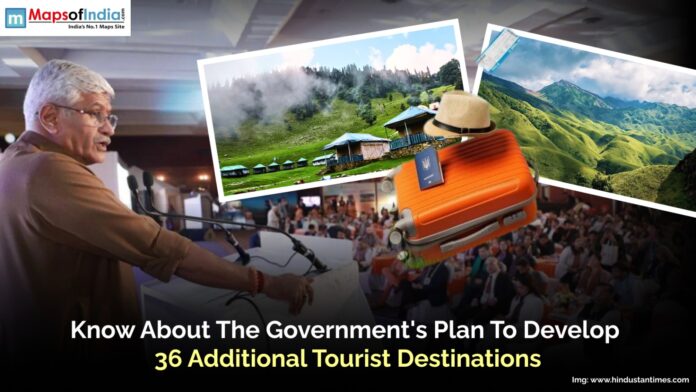Many tourist spots grace the country, which is significant for the economy by generating employment and promoting culture among the locals and foreigners. Realising the potential, the government has unveiled a new scheme to dedicate 36 more tourist sites. The initiative will encourage tourism and heritage sites to boost sustainable travel experiences in the country. So, for this article, dive into the details of the new scheme, including its aims, benefits, challenges, and potential broader effects on tourism and the economy.
Overview of the New Scheme
The new plan is integrated into the government’s overall strategy for developing tourism, tourism infrastructure, and tourism attractions, which will ensure the development of sustainable tourism. The 36 selected sites mix historical, cultural, natural, and adventure tourism potential. To promote religious tourism potential, the government intends to make these sites accessible, appealing, and equipped with advanced facilities to encourage local and international tourists.
The plan has several provisions for:
- Creating the foundational facilities (road transportation infrastructure and communication networks)
- Historic and cultural site restoration and preservation
- Promoting eco-tourism and sustainable travel practices.
- E-tourism for a better tourist experience
The government has allocated a lot of budget to ensure that these developments are carried out strictly according to global tourism standards and are sustainable.
Objectives of the Scheme
Some of the primary objectives of the scheme are:
-
Boosting Economic Growth
One main contributor to the tourism sector is GDP. Hopeful of creating job opportunities, promoting entrepreneurship, and bringing in private investment in the hospitality and services sectors, the government plans to develop these 36 sites.
-
Promoting Sustainable Tourism
Sustainability is the backbone of this initiative. The government plans to implement these sites in an eco-sensitive manner and tourism practices in a conscientious manner with eco-friendly infrastructure.
-
Enhancing Cultural and Heritage Preservation
Most of these 36 sites are of historic and cultural significance. To ensure their preservation and good condition for generations to visit as huge tourist attractions, they must be protected.
-
Boosting Foreign Exchange Earnings
This would be a source of foreign currency from overseas arrivals, strengthen the economy, and increase the interaction of world cultures.
-
Enhancing Regional Development
Most of the selected sites, though, are in the world’s rural or less explored areas. Their development will elevate these areas, generating fresh economic opportunities for the local communities.
Data Collection and Validation for Drawdown Sites
Identified from different states and regions, the government has earmarked 36 sites, blending everything from heritage sites and natural landscapes to adventure tourism spots and spiritual hubs. There are some significant sites, including:
- Heritage Sites: Restoration and facilities at ancient forts, palaces and UNESCO heritage sites
- Natural Attractions: National parks, wildlife sanctuaries and dams with beautiful views will be advertised for eco-tourism.
- Adventure Tourism: Trekking, river rafting, paragliding, and other adventure sports will be developed in mountain ranges, rivers, and deserts.
- Spiritual Destinations: Improvements will be made at popular pilgrimage sites to facilitate more convenience and better access for devotees.
Economic and Social Benefits
-
Expanding Opportunities for Job Creation and Entrepreneurship
This can be directly generated, in fact, and indirectly through research while developing tourist destinations. Everything from construction and maintenance jobs to hospitality, travel agencies, and businesses in the area will thrive from this initiative and employ a significant number of workers.
-
Infrastructure Development
It will also benefit local residents; better roads, airports, railway connectivity, and public utilities will cater to tourists and the local population alike.
-
Local Community Development
This initiative will enable local artisans, craftspeople, and small businesses to access a larger market for their products and services.
-
Safeguarding of Cultural Heritage
The finances allocated towards heritage conservation will facilitate the restoration of ancient monuments and buildings, guaranteeing they continue contributing towards the very fabric of the country’s history and cultural identity.
-
Foreign Direct Investment (FDI) Opportunities
This will ultimately increase foreign direct investment by attracting international investors into the hospitality and service industry through improved tourism facilities.
Challenges and Solutions
The new scheme has interesting possibilities, but it comes with a few challenges to its operation:
-
Environmental Concerns
Tourism could also cause ecological damage if not controlled. The government should promote strict eco-tourism policies and sustainable practices from waste management to the volume of tourists and eco-friendly framework.
-
Costs Associated with the Development of Infrastructure
Upgrading infrastructure can be expensive. The government will collaborate with private sector partners and welcome funding from international tourism development bombshells.
-
Managing Over-Tourism
Certain tourist traps are bursting at the seams and may be in danger of becoming less desirable or less sustainable. Implementing visitor caps, promoting alternative destinations and improving crowd management plans can alleviate this problem.
-
Safety and Security
Tourists’ safety must be a priority. The government plans to step up security at these sites, including surveillance, trained tourist police, and emergency response teams.
-
Promotion and Marketing
If you want to attract international tourists, you need to promote effectively. To improve visibility, you plan to leverage digital marketing efforts, influence tourism experts, and participate in internationally renowned events.
Government and the Private Sector Collaboration
To this end, the government has been consulting private stakeholders to ensure the success of this initiative. Tourism sites will be developed with PPP (public-private partnership) financing and management. The startup will collaborate with travel agencies, hospitality chains, and tech companies to improve tourism experiences and services.
Effect on Domestic and International Travel
The development of these 36 tourism sites is expected to have a significant impact on domestic and international tourism:
- Domestic Tourism: More well-maintained and attractive destinations will encourage citizens to explore their country, boosting local tourism.
- International Tourism: Improved facilities, better marketing, and enhanced visitor experiences will attract more global travellers.
- Revenue Growth: Increased tourist footfall will lead to higher revenue generation for both the government and private businesses involved in tourism.
Future Prospects
The scheme would be a box office model for future tourism development projects. If the government’s scheme works, it can be extended to more destinations and strengthen the country’s tourism industry. The economy grows without destroying the environment; tourism is sustainable and responsible.
Conclusion
With a new strategy in place, the government’s plan to create an additional 36 tourist locations is set to enhance the tourism sector and protect the country’s culture while stimulating the economy. The program will transform the nation’s tourism offer, improving the country’s attractions and sustainable tourism practices. However, this ambitious plan can succeed with good planning, collaboration between government and private, and a great marketing plan.




